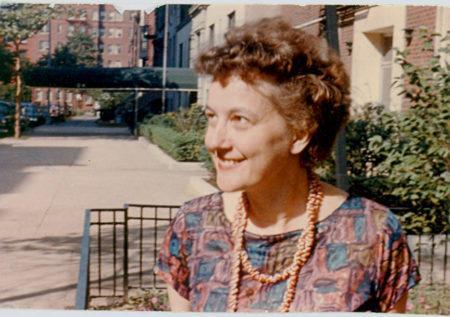Bernice Fisher (Bernice Fisher)

As an activist Bernice Fisher headed a cell with the Fellowship of Reconciliation (FOR) in Chicago to concentrate on race relations. This small cell provided the people for the beginnings of the Committee of Racial Equality (CORE). James Farmer was among the co-founders. The founding members of CORE were James L. Farmer, Jr., Bernice Fisher, George Houser, Homer A. Jack, James Russell Robinson, and Joe Guinn. Bayard Rustin, while not a founder of CORE, was a campus traveler for the Fellowship of Reconciliation; he worked with and advised the founders. Houser reported that James Farmer, in addition to his Chicago activities, traveled the country with FOR and spoke about his national vision for CORE. He said that Fisher was the nuts and bolts person for CORE in Chicago and later St. Louis. Houser mentioned pre-CORE and initial activities in Chicago of Jim Farmer, Jim Robinson, Bernice Fisher, Homer Jack and Joe Guinn that included the Fellowship house (an early effort at desegregating housing), Jack Spratt restaurant sit-in, and White City roller-rink among others. He spoke highly of Bernice Fisher and of her importance to the development of CORE. Bernice Fisher has been called the “godmother of the restaurant ‘sit-in’ technique” by fellow activist and union organizer Ernest Calloway, who worked closely with Fisher in St. Louis and admired her. Fisher worked tirelessly to establish the Committee On Racial Equality. Soon the founders, including Fisher, changed the name to Congress of Racial Equality CORE. This group introduced the sit-in as a tactic in challenging racial segregation in public accommodations. Fisher was instrumental in establishing the sit-in as a nonviolent technique in the Civil Rights Movement. In 1942 CORE’s six founders followed the nonviolent organizing techniques outlined in Krishnalal Shridharani’s War Without Violence. This was Shridharani’s doctoral thesis at Columbia, and within the year had become a national bestseller. Shridharani, an intimate of Gandhi, who had been jailed in the Salt March, had codified Gandhi’s techniques. Gandhi had not wanted his followers to codify his teachings, as he had wanted people to come to India, study intensively and experience the movement first-hand. However, the British were barring Gandhi’s followers from India, and travel to India was beyond the means of most of his followers. Fisher made a list of rules to follow at demonstrations, based on Gandhi’s teachings, that was distributed as a handbill at some demonstrations.
Following Gandhi’s first rule of involving the community and finding out its priorities, this first group of Fisher’s concentrated on integrating housing, repealing laws against integrating neighborhoods in Chicago, and integrating restaurants and amusement venues in Chicago. News of CORE’s work spread and others followed their lead. In 1943, shortly after the first CORE sit-ins, a group of seventeen young women at Howard University in Washington DC began an unpublicized sit-in at a luncheonette in the Howard neighborhood. They had become acquainted with CORE through Fellowship of Reconciliation Campus Travelers Bayard Rustin and James L. Farmer. The group at Howard included Ruth Powell, Marianne Musgrave, Patricia Roberts, & Juanita Morrow Nelson, and they were represented by Pauli Murray, who was then in Howard Law School. Bernice Fisher became an organizer of department store workers in Chicago. During World War II, wages were frozen by government order, but despite a freeze on prices, inflation was rampant. Working conditions for department store employees were onerous: women were not allowed to sit at work, they had no regular breaks, wages were low, and the stores were understaffed. Better pay for women was available in industry, for those who were free to take advantage of the opportunity.
Bernice Fisher was brought to St. Louis by Harold Gibbons of The Teamsters, one of the most progressive labor leaders in America at the time. Gibbons had hired Ernest Calloway, an African-American organizer, who would work in the segregated mid-South for the Teamsters. He hired Fisher on the recommendation of Calloway, who had been impressed by her work in Chicago. During her years in St. Louis, Fisher organized that city’s chapter of CORE, which produced many of the organization’s national leaders. St. Louis CORE kept the national organization going in the late 1940s and the 1950s. They refined many of the techniques promoted by the Chicago group. Others associated with the St. Louis chapter were Marian O’Fallon Oldham, Charles Oldham, Irving & Margaret Dagen, Joe & Billie Ames, Marvin Rich, Norman Seay and Wanda Penny. St. Louis CORE became a leading exponent of the nonviolent direct action as applied to race relations. During the last ten years of her life, Fisher was active with the Concord Baptist Church of Christ in Brooklyn, New York. She was Co-Chairman with Cyprian Belle Concord of the Social Action Committee created by the Concord Baptist Church. Bernice Fisher lived most of her adult life in New York, St. Louis, and Chicago. She participated in many civil-rights nonviolent direct-action activities and labor union anti-discrimination efforts in those cities. She was long associated with the labor movement and served as an official with several unions, including the United Federation of Teachers, Retail Wholesale and Department Stores Union, CIO; the Government and Civic Organizing Committee in Chicago; the American Federation of State, County and Municipal Workers in New York, and others. She had also been active with the Housing Conference of Chicago. She was also serving on the executive board of Brooklyn NAACP and on the National Board of the Workers Defense League. She is buried at The Evergreens Cemetery, Brooklyn, N.Y.
Born
- December, 08, 1916
- USA
- Punxsutawney, Pennsylvania
Died
- May, 02, 1966
- USA
- New York, New York
Cemetery
- The Evergreens Cemetery
- Brooklyn, New York
- USA

